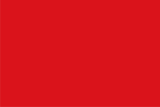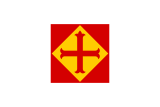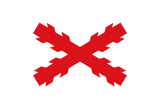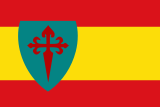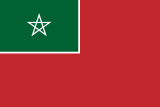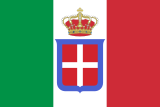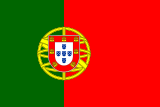Nationalist faction (Spanish Civil War) facts for kids
Quick facts for kids Nationalist faction |
|
|---|---|
| Bando nacional | |
 
Left: Flag until 1938 / Right: Flag from 1938
|
|
| Leader(s) | |
| Dates of operation | 17 July 1936 – 1 April 1939 |
| Ideology | Totalitarianism Spanish nationalism Authoritarian conservatism |
| Political position | Right-wing to far-right |
| Part of | |
| Allies | |
| Opponents | Republican faction |
|
|
|
The Nationalist faction (called Bando nacional in Spanish) was a major group in the Spanish Civil War from 1936 to 1939. This group was also known as the Rebel faction. It was made up of different political groups that leaned to the right. They supported a military takeover in July 1936 against the Second Spanish Republic and the Republican faction. Their goal was to remove the president, Manuel Azaña.
The Nationalist faction included groups like the Falange, the CEDA, and two different groups of monarchists. These monarchists wanted to bring back a king to Spain. In 1937, all these groups joined together to form the FET y de las JONS. After the first leaders of the faction died, General Francisco Franco took charge. He led the Nationalists through most of the war and became the dictator of Spain until he died in 1975.
The name "Nationalists" was first used by Joseph Goebbels from Nazi Germany. He used it to make Germany's help to the Spanish rebels seem more official. The rebel leaders liked this name. They had already been called "Crusaders" by the Bishop of Salamanca, Enrique Pla y Deniel, and they also called their fight a "Crusade."
Some historians believe the term Bando nacional was part of the Nationalist group's own propaganda. During the war, the Nationalists and their supporters used this term. Their opponents, however, called them "fascists" (fascistas) or "sectarians" (facciosos).
Contents
Who Supported the Nationalists?
The military uprising had a lot of support both inside Spain and from other countries. In Spain, the Nationalist side was mainly supported by wealthy people, professionals, religious groups, and farmers who owned land. Most of their support came from rural areas where new political ideas had not spread much. These areas included much of Old Castile, La Rioja, Navarre, Alava, parts of Aragon, most of Galicia, and some areas in Extremadura and Andalusia. These places often followed older traditions.
Political Groups in the Nationalist Faction
The Nationalist faction brought together different political parties and groups. Sometimes, these groups had very different ideas. They included conservative groups like the CEDA, liberals, Falangists, Catholics, and groups who wanted a king, such as the Carlists.
The Falange
The Falange Española was a Spanish fascist political party. It was started by José Antonio Primo de Rivera, whose father, Miguel Primo de Rivera, had been a leader in Spain before. The Falange got money from monarchists who wanted a king from the Alfonsist family. When it started, the Falange was against the Church and against having a king. Primo de Rivera, who was a landowner, told the upper classes that Spanish fascism would not get out of their control, unlike in Germany and Italy. In 1934, the Falange joined with another group to form the Falange Española de las JONS.
At first, the Falange was a small group of students. They believed in a strong, nationalist revolution. Before the war, the Falange was involved in street fights with their political rivals. This helped create a feeling of disorder, which right-wing newspapers blamed on the Republic to support a military uprising. Falangist groups tried to create chaos to justify a strong, controlling government. As people became unhappy with the CEDA's slow approach, more and more people joined the Falange. By September 1936, about 35,000 people had volunteered for the Falange. This was 55% of all civilian forces fighting for the Nationalists.
The Falange Española de las JONS was one of the first groups to support the military coup against the Republic, along with the Carlists. After José Antonio Primo de Rivera died, Manuel Hedilla tried to take control of the Falange. But Franco took control instead, as he wanted to lead the entire Nationalist faction. In 1937, Franco announced a new rule to unite all Nationalist political groups, especially the Falange and the Carlists. They became one movement, still called the Falange, but under his leadership, named Falange Española Tradicionalista y de las JONS. Both Falangists and Carlists were angry at first. Falangists felt their ideas were being replaced by the Catholic Church's influence.
After Franco took over, he said the Falange was not fascist. He stated that its founder had said so himself. After this, people in the Nationalist faction stopped calling the Falange "fascists" by 1937. However, Franco did not deny that some fascists were part of the Falange. Franco said the Falange's goal was to include many ordinary people who didn't belong to any group. He promised that strict ideas would not stop this goal. Under Franco, the Falange stopped being against the Church and instead promoted a strong connection between the nation and Catholicism. They still criticized Catholic ideas about peace. Franco's Falange also stopped being against capitalism. A Falange member said that their ideas could work well with capitalism.
The CEDA
The Spanish Confederation of Autonomous Right-wing Groups, known as CEDA, was a Catholic right-wing political group. It was against Marxism. The CEDA was led by José María Gil-Robles y Quiñones. The CEDA claimed it was protecting Spain and "Christian civilization" from Marxism. They said that politics in Spain had become a fight between Marxism and anti-Marxism.
When the Nazi Party came to power in Germany, the CEDA started using similar propaganda. They focused on ideas like authority, love for the homeland, and a strict social order. Gil-Robles even went to a Nazi Party rally in Nuremberg and was influenced by it. After that, he wanted to create a single anti-Marxist group in Spain. Gil-Robles said he wanted to "give Spain a true unity, a new spirit, a totalitarian polity..." He also said, "Democracy is not an end but a means to the conquest of the new state. When the time comes, either parliament submits or we will eliminate it." The CEDA held rallies that looked like fascist rallies. They called Gil-Robles "Jefe", which means "leader," like "Duce" for Mussolini. They even suggested the CEDA might march on Madrid to take power by force.
However, the CEDA did not win enough elections between 1931 and 1936 to form a government. Because of this, some right-wing supporters left the CEDA and started supporting the more aggressive monarchist leader, José Calvo Sotelo. The CEDA then stopped being moderate and started supporting violence against the Republic. They even gave their election money to General Emilio Mola, who was one of the first leaders of the military coup. After this, many young people from the CEDA's youth group joined the Falange, and the CEDA's youth group stopped existing in 1937.
Monarchist Groups
The Carlists
The Carlists were monarchists and very traditional Catholics. They wanted Francisco Javier de Borbón to be the King of Spain. The Carlists were against the Republic, against democracy, and strongly against socialism. They were so against socialism that they even opposed Hitler and Mussolini because they saw socialist ideas in their movements. The Carlists were led by Manuel Fal Condé. Most of their support came from Navarre. The Carlists, along with the Falange, were the first groups to support the military coup against the Republic.
The Carlists had a long history of fighting against Spanish liberalism, going back to 1833. That year, they started a six-year civil war against the government. The Carlists were very strict and did not want to join with other groups. They even believed that non-Carlists could not have honest intentions. During the war, the Carlists' militia, called the Requetés, had about 42,000 members at its peak. By the end of the war in April 1939, their strength was about 23,000. The Carlists' troops were some of the most effective fighters for the Nationalists during the war.
The Alfonsists
The Alfonsists were a group that wanted to bring back Alfonso XIII of Spain as king. This was after the Spanish Second Republic was created in 1931. They were rivals with the Carlists, who wanted a different king. After Alfonso XIII's monarchy was overthrown, his supporters formed Renovación Española, a political party that wanted a king. This party had a lot of money and strong supporters in the Spanish army. However, Renovación Española did not become a large political movement.
In 1934, the Alfonsists, led by Antonio Goicoechea, and the Carlists met with Italian dictator Benito Mussolini. They wanted his support for an uprising against the Republic. Mussolini promised to give them money and weapons. From 1934 to 1936, the popular Alfonsist leader José Calvo Sotelo spoke about the need to "conquer the state." He said this was the only way to create a strong, authoritarian government. Sotelo gave powerful speeches supporting a violent uprising. He stressed that a military revolt against the Republic was needed to stop communism and separatism, which he blamed on the Republic. Sotelo was kidnapped and killed by political opponents on July 13, 1936. This made many on the political right very angry and helped justify the military coup against the Republic.
When the war started, Infante Juan, the son of Alfonso XIII and heir to the throne, asked Franco if he could join the Nationalists' war effort. He wanted to be part of the crew of a warship. He promised not to get involved in politics. But Franco said no. He believed that Infante Juan would become a symbol for the Alfonsists, who were strong in the military.
Military Forces
Army of Africa
The Army of Africa was a military force stationed in Spanish Morocco. It was a leftover from the Rif War and was led by General Francisco Franco. This army included the Spanish Foreign Legion and the Regulares. The Regulares were infantry and cavalry units made up of soldiers recruited from Spanish Morocco, with Spanish officers leading them.
The Regulares were the main attack troops for the Nationalist forces. They were paid well for this. More than 13,000 Moroccan troops were flown to Spain on 20 Junkers Ju 52 planes provided by Hitler. This happened between July and October 1936. Their reputation for cruelty was not random. It was part of a plan by Franco's military leaders to scare the Republican defense lines.
The Army of Africa was the most honored unit in the victory parade in May 1939. It is thought that one in five of its members died during the war. This was twice the casualty rate of the Spanish soldiers. For several years after the war, Franco had a group of Moorish troops as his escorts at public events. This was to remind everyone how important the Army of Africa was to the Nationalist victory.
Civil Guard
About 47% of the Spanish Republican Civil Guard joined the rebels when the civil war began. The highest leader of the Spanish Republican Civil Guard stayed loyal to the Republic. Because of this, the rebel units of the Civil Guard were put directly under the command of the Nationalist army until the war ended.
Help from Other Countries
Italy
Italy, led by the Fascist leader Benito Mussolini, supported overthrowing the Spanish Republic. Mussolini wanted a government in Spain that would be friendly to Italy. Italy did not trust the Spanish Republic because it seemed to favor France. Before the war, Italy had already contacted Spanish right-wing groups. Italy said its reason for getting involved was to stop the spread of Bolshevism (communism) in Spain. Italy's Fascist government saw the threat of Bolshevism as real, especially with volunteers from the Soviet Union fighting for the Republicans. Mussolini gave money and training to the Alfonsists, Carlists, and Falange. He met Falangist leader José Antonio Primo de Rivera in 1933, but at that time, he wasn't very keen on fascism growing in Spain.
By January 1937, an expeditionary force of 35,000 Italian soldiers, called the Corpo Truppe Volontarie, were in Spain. They were led by General Mario Roatta. This group had four divisions. One division was made of regular soldiers, and the other three were made of Blackshirt volunteers. Italy also gave the Nationalist forces fighter and bomber planes, which were very important in the war. In March 1937, Italy even tried to influence the Nationalists' politics. They sent a representative to Spain to urge Franco to unite all the different Nationalist political groups into one fascist "Spanish National Party."
Germany
Nazi Germany provided the Nationalists with supplies, experts, and a strong air force group called the Condor Legion. These German forces flew soldiers and supplies from Spanish Africa to mainland Spain. They also carried out attacks against Republican forces. The Nationalist forces received tanks and aircraft, including the Panzer I tank, and Messerschmitt Bf 109 and Heinkel He 111 planes. The Spanish Civil War became a testing ground for Germany's new weapons. The Condor Legion tested many bombing techniques against the Republican government in Spain, with Franco's permission. However, Hitler always said his long-term plans were peaceful.
Germany had important economic reasons for being in Spain. Germany bought large amounts of minerals from Spanish Morocco. The Nazi government sent a retired general as ambassador to Franco's government. This general supported Franco and the Falange, hoping they would create a Nazi-like government in Spain. The Nationalists' debt to Germany grew quickly because they bought so many German supplies. They needed financial help from Germany because the Republicans had access to Spain's gold reserves.
Portugal
When the civil war started, Portuguese Prime Minister António de Oliveira Salazar quickly supported the Nationalist forces. Salazar's Estado Novo government had tense relations with the Spanish Republic because the Republic allowed Portuguese people who opposed Salazar to live there. Portugal played a very important role in giving Franco's forces ammunition and other supplies.
Portugal did not send many soldiers directly, but it allowed about 8,000 to 12,000 volunteers to fight for the Nationalists. More importantly, Portugal helped the Nationalist faction with supplies and logistics. It also promised Franco and his allies that nothing would stop supplies from crossing the border between the two countries. The Nationalists even called Lisbon "the port of Castile." In 1938, as Franco's victory seemed sure, Portugal officially recognized Franco's government. After the war in 1939, they signed a friendship and non-aggression agreement called the Iberian Pact. Portugal also played an important diplomatic role in supporting Franco's government. They told the United Kingdom that Franco wanted to create a government like Salazar's Estado Novo, not like Mussolini's Fascist Italy.
The Holy See (Vatican City)
Many influential Catholics in Spain, especially conservative and pro-monarchy groups, believed that the Republic's government was responsible for religious persecution. This anger was used by the Nationalist faction after the 1936 coup. The Catholic Church supported the rebel government and called the religious Spaniards who were persecuted in Republican areas "martyrs of the faith." However, some devout Catholics also supported the Spanish Republic. These included high-ranking officers in the Popular Army and Catholic Basque nationalists who opposed the rebels.
At first, the Vatican did not openly declare its support for the rebel side. However, it allowed high Church leaders in Spain to do so and to call the conflict a "Crusade." Throughout the war, Franco's propaganda and influential Spanish Catholics called the secular Republic "the enemy of God and the Church." They blamed the Republic for anti-religious actions, such as closing Catholic schools, damaging religious buildings, and the killing of priests and nuns by angry crowds.
Because Western European countries did not help the Republicans much, the Republican side mainly relied on military help from the Soviet Union. This helped Franco's propaganda portray the Spanish Republic as a "Marxist" and godless state. The Holy See used its wide diplomatic network to support the rebel side. At an International Art Exhibition in Paris in 1937, where both Franco's government and the Republican government were present, the Holy See allowed the Nationalist display to use the Vatican flag. This was because the rebel government's flag was not yet officially recognized. The Holy See was one of the first states to officially recognize Franco's Spanish State, doing so by 1938.
Other Supporters
About 1,000 to 2,000 volunteers from England, Ireland, France, the Philippines, Russia, Poland, Romania, Hungary, and Belgium came to Spain to fight for the Nationalists. Only two British women volunteered as nurses.
See also
 In Spanish: Bando sublevado para niños
In Spanish: Bando sublevado para niños


